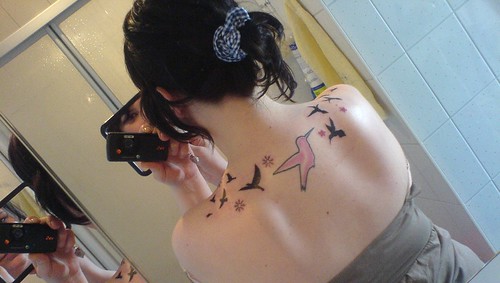Friday, July 29, 2011
SMALL BIRD TATTOO
The impetus for the development of the art were the development of the art of woodblock printing and the release of the popular Chinese novel Suikoden, a tale of rebel courage and manly bravery illustrated with lavish woodblock prints showing men in heroic scenes, their bodies decorated with dragons and other mythical beasts, flowers, ferocious tigers and religious images. The novel was an immediate success, and demand for the type of tattoos seen in its illustrations was simultaneous. Until the Edo period (1600–1868 AD) the role of tattoos in Japanese society fluctuated. Tattooed marks were still used as punishment, but minor fads for decorative tattoos—some featuring designs that would be completed only when lovers' hands were joined—also came and went. It was in the Edo period, however, that Japanese decorative tattooing began to develop into the advanced art form it is known as today. The Ainu people, the indigenous people of Japan, are known to have used tattoos for decorative and social purposes. There is no known relation to the development of irezumi. Starting in the Kofun period (300–600 AD) tattoos began to assume negative connotations. Instead of being used for ritual or status purposes, tattooed marks began to be placed on criminals as a punishment (this was mirrored in ancient Rome, where slaves were known to have been tattooed with mottoes such as "I am a slave who has run away from his master"). In the following Yayoi period (c. 300 BC–300 AD) tattoo designs were observed and remarked upon by Chinese visitors. Such designs were thought to have spiritual significance as well as functioning as a status symbol. Tattooing for spiritual and decorative purposes in Japan is thought to extend back to at least the Jōmon or paleolithic period (approximately 10,000 BC). Some scholars have suggested that the distinctive cord-marked patterns observed on the faces and bodies of figures dated to that period represent tattoos, but this claim is by no means unanimous. There are similarities, however, between such markings and the tattoo traditions observed in other contemporaneous cultures. The word can be written in several ways, each with slightly different connotations. The most common way of writing irezumi is with the Chinese characters 入れ墨 or 入墨, literally meaning to "insert ink". The characters 紋身 (also pronounced bunshin) suggest "decorating the body". 剳青 is more esoteric, being written with the characters for "stay" or "remain" and "blue" or "green", and probably refers to the appearance of the main shading ink under the skin. 黥 (meaning "tattooing") is rarely used, and the characters 刺青 combine the meanings "pierce", "stab", or "prick", and "blue" or "green", referring to the traditional Japanese method of tattooing by hand. Irezumi (入れ墨, 入墨, 紋身, 刺花, 剳青, 黥 or 刺青) is a Japanese word that refers to the insertion of ink under the skin to leave a permanent, usually decorative mark; a form of tattooing.
Subscribe to:
Post Comments (Atom)








No comments:
Post a Comment